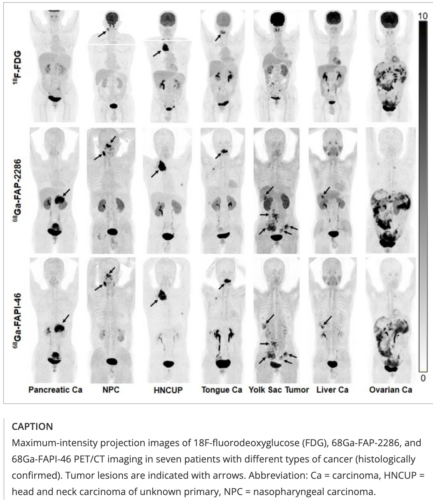Source: www.eurekalert.org
Author: news release, Society of Nuclear Medicine and Molecular Imaging
A new radiotracer, 68Ga-FAP-2286, has been found to be more effective than the most commonly used nuclear medicine cancer imaging radiotracer, 18F-FDG. In a study published in the March issue of The Journal of Nuclear Medicine, 68Ga-FAP-2286 detected 100 percent of primary tumors across multiple cancer types as compared to 18F-FDG, which identified only 80 percent. 68Ga-FAP-2286 was also more effective in detecting lymph node metastases and distant metastases.
Currently, 18F-FDG, which measures glucose metabolism, is used extensively in nuclear medicine cancer imaging. Recent advances have shown that fibroblast activation protein (FAP), which is overexpressed in cancer cells, may be a better target for the imaging of solid tumors.
“In this study we aimed to investigate the diagnostic accuracy of 68Ga-FAP-2286—a radionuclide developed to target FAP—for detecting the primary and metastatic lesions in patients with various types of cancer,” said Haojun Chen, MD, PhD, nuclear medicine physician at the First Affiliated Hospital of Xiamen University in Xiamen, China.
Sixty-four patients with 14 types of cancer were included in the study. Sixty-three of the patients underwent paired 68Ga-FAP-2286 and 18F-FDG PET/CT, and 19 patients underwent paired 68Ga-FAP-2286 and 68Ga-FAP-46 (another 68Ga-radiolabeled variant). Results were evaluated and compared.
68Ga-FAP-2286 PET yielded a higher radiotracer uptake, tumor-to-background ratio and tumor detectability than 18F-FDG. In addition, 68Ga-FAP-2286 and 68Ga-FAPI-46 yielded comparable clinical results.
“The novel radionuclide 68Ga-FAP-2286 is shown to be a promising FAP-inhibitor derivative for safe cancer diagnosis, staging and restaging,” stated Chen. “Specifically, it may be a better alternative for diagnosing the cancer types that exhibit low-to-moderate uptake of 18F-FDG, such as head and neck, gastric, pancreatic and liver cancer.”
Chen also noted that FAP-2286 not only exhibits promising characteristics for diagnosis, but also for cancer treatment. “Due to its molecular makeup, FAP-2286 can be paired with 177Lu to create a new radiopharmaceutical therapy,” he said. “177Lu-FAP 2286 has the potential to offer potent and selective FAP binding, which could lead substantial therapeutic efficacy for cancer patients in the future.”
This study was made available online in September 2022.
Authors:
The authors of “PET imaging of fibroblast activation protein in various types of cancers by using 68Ga-FAP-2286: Comparison with 18F-FDG and 68Ga-FAPI-46 in a single-center, prospective study” include Yizhen Pang and Liang Zhao, Department of Nuclear Medicine & Minnan PET Center, The First Affiliated Hospital of Xiamen University, Xiamen, China, and Department of Radiation Oncology, The First Affiliated Hospital of Xiamen University, Xiamen, China; Tinghua Meng, Weizhi Xu, Hua Wu, Long Sun, and Haojun Chen, Department of Nuclear Medicine & Minnan PET Center, The First Affiliated Hospital of Xiamen University, Xiamen, China; Qin Lin, Department of Radiation Oncology, The First Affiliated Hospital of Xiamen University, Xiamen, China; Jingjing Zhang, Department of Diagnostic Radiology, National University of Singapore, Singapore, Singapore, and Clinical Imaging Research Centre, Centre for Translational Medicine, Yong Loo Lin School of Medicine, National University of Singapore; and Xiaoyuan Chen, Departments of Diagnostic Radiology, Surgery, Chemical and Biomolecular Engineering, and Biomedical Engineering, Yong Loo Lin School of Medicine and Faculty of Engineering, National University of Singapore, Singapore, Clinical Imaging Research Centre, Centre for Translational Medicine, Yong Loo Lin School of Medicine, National University of Singapore, Singapore, and Nanomedicine Translational Research Program, NUS Center for Nanomedicine, Yong Loo Lin School of Medicine, National University of Singapore, Singapore.


Leave A Comment
You must be logged in to post a comment.